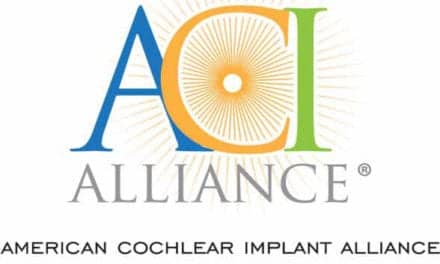BY Amanda Smith, AuD; Douglas L. Beck, AuD; Michelle Petrak, PhD; and Cammy BAhner, MS
Using VNG in tandem with traditional vestibular/balance tests
Editor’s note: The following article is Part 2 of a series that began with the article “Screening Tests for Patients with Dizziness” in the April 2012 HR1.
Although the vestibular and auditory systems work in tandem and share many anatomic and physiologic features, the vestibular system is phylogenetically older2 and arguably more intricate. Each vestibular system is comprised of the utricle, saccule, and three semi-circular canals—each of which is responsible for detecting a specific plane of motion.
To maintain balance in a healthy person, the brain generally perceives equal-but-opposite input from the left and right vestibular systems. The vestibular systems are mirror images of each other; as one side sends excitatory information to the brain, the other side sends equal and opposite inhibitory information. If one vestibular organ is weak or malfunctioning, the brain perceives a “mismatch” of vestibular sensory input, resulting in dizziness.
The vestibulo-ocular reflex (VOR) is a reflexive eye movement, which normally occurs in response to head movement. The VOR allows humans to focus on stationary objects while the head (and body) is in motion. Dysfunction of the VOR results in complaints of chronic unsteadiness, feelings of “motion sickness,” and disorientation. Abnormalities of the VOR demonstrated through unusual/abnormal eye movements are accurately and easily captured and recorded via videonystagmography.
Videonystagmography (VNG)
To diagnose and treat dizziness, an expert audiologist working in a sophisticated vestibular laboratory (including ENG, VNG, VEMP, Rotary Chair, VAT, CDP, and more) would be ideal. Unfortunately, experts and state-of-the-art equipment are not always available and therefore less sophisticated (but still very useful) tests may prove beneficial with regard to establishing a differential diagnosis for the dizzy patient.1
This article explores the benefits of using VNG in tandem with traditional vestibular/balance tests. VNG offers significant advantages over traditional electrode-based electronystagmography (ENG) tests with utility for adults and children.1
Hain3 reported VNG’s superiority over ENG based on higher resolution, greater stability, and an increased ability to observe, capture, and record torsional eye movement. McCaslin and Jacobson4 reported a number of advantages with VNG compared to traditional ENG, including:
- VNG goggles are applied quickly to the patient;
- VNG recording systems generally have a low noise floor thus providing better quality recordings; and
- VNG recordings can be recalled as needed for later analysis.
Of note, ENG electrodes are traditionally positioned around the eyes to record and measure the corneo-retinal potential (CRP), whereas VNG uses (infrared or other technology) goggles to record the movement of the pupil.5 VNG requires less preparation time (no scrubbing, pasting, or securing electrodes) and does not require verifying impedances and cleaning/sterilizing electrodes.
Vestibular Testing
Because the vestibular system is such an intricate system, there is no “single test” to diagnose vestibular disorders. Rather, assessment of the vestibular system requires a battery of tests—each stimulating and stressing a specific structure, while probing and evaluating for dysfunction. The suggested basic test battery protocol for vestibular disorders is:
- Patient history
- Otoscopy
- Complete audiometric studies
- Clinical exams (see previous article)
- Videonystagmography (VNG)
- Spontaneous nystagmus
- Gaze evoked nystagmus
- Smooth pursuit tracking
- Saccade testing
- Dix-Hallpike Maneuver
- Positional testing
- Caloric irrigation (to be addressed in the third article in this series)
Although audiologists take thorough case histories daily, when working with a dizzy patient, adding some/all of these questions may prove beneficial (see Smith et al1 for complete details):
- Describe your symptoms without using the word “dizzy”?
- Have you recently been ill?
- Have you had a recent change in medications?
- Are there unusual sounds in your ears when you’re dizzy?
- Do you experience dizziness every time you move your head in a certain manner (looking up, lying down, bending over, etc…)?
- Do your symptoms occur only when you turn your head or lie down on one side?
- Do you have a “stuffy” feeling in one or both ears when you’re dizzy?
- Do you experience dizziness right after you lie down?
The VNG battery can be thought of as three core test protocols:
1) Ocular motility tests,
2) Positional tests, and
3) Caloric irrigation.
Ocular motility tests are used to rule out the presence of underlying spontaneous nystagmus, and ocular tests help assess the VOR. Positional tests help determine whether the patient’s complaints are related to the position of the head in space. Finally, caloric irrigation analyzes the intensity of the patient’s vestibular response and grossly determines whether symmetrical vestibular function is present or absent across the unilateral vestibular systems.
Basic VNG Setup
The VNG examination room includes an examination table to allow the patient to lie comfortably throughout the evaluation process. Although the table itself requires a “footprint” of approximately 6 by 2 feet, the audiologist will need to be able to walk entirely around the table while the patient is supine. Therefore, physical space is often a concern.
The VNG computer monitor should be positioned so the audiologist can easily visualize the patient’s eye movements and subsequent tracings on the display screen while working with and adjusting the patient. VNG goggles should be placed on the patient (with the patient assisting) so as to be “snug,” but not uncomfortable.
VNG Test Battery
Spontaneous Nystagmus. The presence of spontaneous nystagmus may bias all other test results. 
Gaze Test. Gaze testing (Figures 4 and 5) assesses the patient’s ability to maintain a steady gaze without extraneous movements (ie, square wave jerks or nystagmus). The inability to maintain a steady gaze may be an indication of a central or peripheral vestibular system lesion. Parameters tested are: primary (straight ahead), gaze left, gaze right, gaze up, and gaze down.
Smooth Pursuit. Smooth Pursuit assesses the patient’s ability to accurately track a visual target in a smooth, controlled manner. Smooth pursuit assesses the patient’s central vestibular system. Although several methods of smooth pursuit tracking have been researched, it is the controlled-velocity method that has proven to be the most clinically useful and is described here.
A patient with the ability to perform smooth pursuit tracking normally will produce a tracing in which the 
stimulus and response are identical (Figures 6 and 7). Smooth pursuit is the most sensitive (of the ocular motility tests) to aging (ie, older patients are more likely to produce errors). Further, smooth pursuit is an unusual task, and it may need to be “taught” to the patient over two or three “trials.”
Saccades. Saccade testing (Figures 8-10) is used to assess the patient’s ability to accurately move the eyes from one designated focal point to another in a single, quick movement. The ability to accurately perform saccade testing assesses the patient’s central vestibular system.
The random saccade paradigm has been established as the most useful of saccade testing in which the patient is instructed to follow a digitally controlled dot across their field of vision by moving their eyes only (not their head). Patients with normal responses will produce a tracing upon which the stimulus and response are identical. The analysis of the saccade test consists of three parameters:
- Latency: How long it takes the patient’s eyes to find the target.
- Accuracy: Whether the patient can move his eyes directly to the target without “overshooting” or “undershooting” the target.
- Velocity: How fast the eyes are moving from point to point.
Optokinetics. The optokinetic reflex is mediated within the central vestibular system and allows the eyes to follow objects in motion while the head remains stationary. The inability to produce symmetric optokinetic nystagmus (OKN) implies a dysfunction of the central vestibular system. OKN gives only a gross indication of the integrity of the central vestibular system—smooth pursuit testing and saccade testing are more reliable tests of the central vestibular system.
OKN is measured to the right and left at varying velocities. A patient with the ability to perform OKN normally will produce tracings that are fairly symmetric with relatively uniform “beats” in appearance (Figure 11). An abnormal response seen in one direction (but not the other) is highly suggestive of a vestibular disorder (Figure 12). However, if the abnormal response is not accompanied by spontaneous 
Figures 10 – 14 nystagmus, the disorder is likely central.
Positional Testing. Positional testing (Figures 13 and 14) is used to determine whether a change of position provokes nystagmus. Positional testing is an evaluation of the peripheral vestibular system and reflects an asymmetry in the tonic resting rate of the two vestibular end organs. It is particularly important to rule out spontaneous nystagmus prior to positional testing.
Positional testing is performed with vision-denied (using covered VNG goggles) such that the patient cannot suppress nystagmus by focusing their eyes on a spot in space. Patients who test positive (within 15 seconds) after/during moving from one position to another often have a vestibular lesion in the downward ear. Positional testing is also used in the diagnosis of benign paroxysmal positional vertigo (BPPV).
Dix-Hallpike Maneuver. The Dix-Hallpike Maneuver is used to differentiate positional vertigo from benign paroxysmal positional vertigo. The maneuver is best performed with vision denied and with the patient’s arms crossed over the chest. The examiner has the patient seated on the table and quickly assists them in lying back and “hanging their head” off each side of the table (one side per maneuver).
If the patient does not have positional vertigo (Figures 15), the tracing will be a straight line (normal eye movement is expected). If the patient does have vertigo and displays nystagmus, it is important to watch
the video monitor for several characteristics in order to differentiate “positional vertigo” from BPPV (Figure 16), such as:
- Does the nystagmus have delayed onset of 2-20 seconds?
- Is the nystagmus torsional (“rotary”)? Does the nystagmus fatigue after a few seconds?
- Does the nystagmus reverse direction when you return the patient to a sitting position?
- Is the nystagmus less intense upon retest?
Generally all or most of these characteristics will present together to support the differential diagnosis of BPPV. However, if nystagmus is present in the absence of the (above-noted) BPPV characteristics, it is likely a different peripheral vestibular disorder (ie, not BPPV) is the source of the problem.
Conclusion
The dizzy patient presents challenges to the audiologist; a clear differential diagnosis rarely depends on one specific test. Rather, the differential diagnosis emerges after completion and analysis of a battery of tests considered in tandem with the patient’s history, physical findings, and unique signs and symptoms. Of significant importance, quality of life improvements are often available for the dizzy patient following accurate diagnosis and appropriate medical, surgical, or vestibular rehabilitation treatment.6
Traditional balance testing has been carried out (for decades) via electronystagmography, which employs electrodes to measure and record the corneo-retinal potential, secondary to eye movements associated with the VOR. Videonystagmography offers multiple advantages over electronystagmography with regard to preparation protocols and timing, and provides a much improved and higher quality direct recording of eye movement to better support a differential diagnosis. VNG is preferred and recommended over ENG for these same reasons.7
Bithermal Caloric Irrigation via VNG will be addressed in Part 3 of this series.
Amanda Smith, AuD, is director of audiology at Lakeside Physicians, Granbury, Tex; Douglas L. Beck, AuD, is director of professional relations at Oticon Inc, Somerset, NJ; Michelle Petrak, PhD, is director of clinical audiology at Interacoustics A/S, Assens, Denmark; and Cammy Bahner, MS, is senior clinical audiologist at Interacoustics US, Eden Prairie, Minn.
References
1. Smith A, Petrak M, Bahner C, Beck DL. In the trenches, Part 1: Screening tests for patients with dizziness. Hearing Review. 2012;19(4):12-23. Available at: /practice-management/17237-in-the-trenches-part-1-screening-tests-for-patients-with-dizziness
2. Cullen K, Sadeghi S. Scholarpedia, 2008;3(1):3013. Available at: http://www.scholarpedia.org/article/Vestibular_system
3. Hain T. Vestibular function—making the right interpretation with the right test. Hear Jour. 2011;64(12):26-30.
4. McCaslin DL, Jacobson GP. Current role of the videonystagmography examination in the context of the multidimensional balance function test battery. Sem Hear. 2009;30(4):242-253.
5. Meyers BL, Beck DL. Vestibular learning manual: interview with Bre Lynn Myers (2011). Available at: http://www.audiology.org/news/Pages/20111005.aspx
6. Beck DL, Petrak MR, Bahner CL. Virtual Reality & Vestibular Rehabilitation Therapy—VRT can improve balance and quality of life. Advance for Long-Term Care Management. 2011;14(4):22. Available at: http://long-term-care.advanceweb.com/Archives/Article-Archives/Virtual-Reality-Vestibular-Rehabilitation-Therapy.aspx
7. Pietkiewicz P, Pepas R, Su?kowski WJ, Zielinska-Blizniewska H, Olszewski J. Electronystagmography versus videonystagmography in diagnosis of vertigo. Int J Occup Med Environ Health. 2012;25(1):59-65. Epub 2012 Jan 5. Available at: http://www.ncbi.nlm.nih.gov/pubmed/22219058
Other Recommended Readings
American Academy of Audiology (AAA) Position Statement on the Audiologist’s Role in the Diagnosis & Treatment of Vestibular Disorders. Available at: http://www.audiology.org/resources/documentlibrary/Pages/VestibularDisorders.aspx
Beck DL, Petrak MR, Bahner CL. Advances in pediatric vestibular diagnosis and rehabilitation. Hearing Review. 2010;17(11):12-16. Available at: /all-news/17030-advances-in-pediatric-vestibular-diagnosis-and-rehabilitation
The Role of Videonystagmography (VNG). http://www.audiology.org/news/Pages/20091209.aspx





